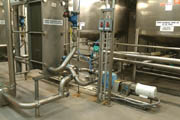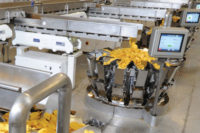

Engineering design of the Pepperidge system was accomplished by Bryan Downer, liquids segment manager at Shick USA. A graduate of Southwest Missouri State University with a B.S. degree in mechanical engineering physics and design, Downer worked for 10 years with CSI Group, designing sanitary liquid handling systems for pharmaceutical and food applications, before joining Shick three years ago. Food Engineering recently spoke with Downer about the Pepperidge project and the refinements needed to improve dough-brew quality.
FE: What are the components of a brew system?
Downer: In Bloomfield, there are two mix tanks where the flour, yeast and nutrients are agitated before the solution is pumped to one of three ferment tanks. One tank is mixing while the other is transferring, giving us a continuous flow. The fermentation tanks are fairly warm, about 80
FE: What design changes were needed to improve over earlier brew systems?
Downer: We took a ground-up approach, looking at what the product should be at the mixer, then determining what we had to do to achieve that. A major issue in older systems was inadequate cleaning. As the mixture loses hydration, layers of crust form, and that's difficult to remove. Many bakeries were disassembling their plate heat exchangers every three to four weeks. That is labor intensive and expensive. Based on our experience in dairy and brewing, we knew there was a way to eliminate the problem.
FE: What was the solution?
Downer: Partly it had to do with selecting a heat exchanger with a minimum number of contact points for the plates. We evaluated a number of designs from various manufacturers before selecting a unit from Chester-Jensen Co. that is well suited to viscous product. The free-flow design is less prone to fouling with a brew that is 45 percent flour.
Another consideration was the CIP (clean-in-place) system. Positive displacement pumps move the brew from mixing to holding tanks and through the pipe loops, but the Reynolds number of turbulence isn't adequate to remove any buildup that might have occurred in the heat exchanger. The solution was to include a centrifugal pump at the point of entry for CIP fluids into the exchanger. The CIP system pumps solvent at a 200 gallons per minute (GPM) flow rate. With the booster pumps, 400 GPM is generated. That would be too much for the entire CIP system to bear, but it works perfectly for the heat exchanger. It took quite a bit of time to calculate the flow rates for the various pumps, but the accelerated velocity does the job. Pepperidge took apart the heat exchanger after nine months to assure themselves that there were no problems. The plates were perfectly clean.
FE: What are the advantages of the reduced frequency of heat exchanger maintenance?
Downer: It could easily require 20 man-hours every time you take it apart. The gaskets might have to be replaced, there's potential damage to the plates, and the plates might not be reassembled in the right order and have to be taken apart. Usually a weekly CIP cleaning is enough to maintain sanitation. We recommend overhauling the heat exchanger once a year, but if it's not a dairy, some processors wait as long as six years.
FE: What other problems existed with earlier generation brew systems?
Downer: Some shear is necessary during mixing, but there comes a point when the process begins to extract gluten strands. They tend to attach to one another to form a long, elastic strand. That poses a problem for both the end product and the heat exchanger. Our focus was on engineering a system that mixed adequately to get the lumps out but did not extract gluten strands.
Each system is custom designed based on the space available and production demands. In Bloomfield, ceiling height was fairly low, which resulted in a unique height-to-width ratio for the mixing tanks. To ensure that the fluid was moving up and down and side to side at a consistent flow rate, we designed a high-sheer agitator in the middle of the tank, with a blade at the mid point and on the lower portion of the shaft. There's also a sweep agitator on the outer edge of the tank, running in a counter motion to the center shaft. The result is consistent sheer throughout the batch.
FE: Sanitary design sometimes gets short shrift, particularly when there is a kill step such as a bakery oven. Does that argue against the expense of a CIP system?
Downer: There are still carbon steel holding tanks being used in some segments of the food industry, but that kind of equipment is substandard. It doesn't cost much more for sanitary systems, and they'll still be acceptable in 10 years. We designed the Pepperidge CIP system just like a dairy's, with 3A pumps, clean breaks and automatic valves to ensure there is no contamination potential.
Being able to clean equipment properly is an important part of maintenance. Anyone who has to routinely break down pumps for cleaning has experienced premature seal failure and dropped rotors and face plates. All that adds cost. A CIP system doesn't just eliminate contaminants and microbial growth; it helps maintain equipment and makes it last longer.
FE: Are the improvements sufficient to revive interest in brew systems?
Downer: We've received a positive response from bakers, including some wholesalers who pulled out components from existing systems and shut them down 10 years ago. When you can tell them what problems have been fixed, there is definite interest.
There are a lot of advantages over alternative methods, including the freeing up of floor space, greater product consistency and flavor, and more production flexibility. You can test pH, perform acid-level measurement, and conduct other quality-assurance tests that allow you to develop a baseline record of the product and the adjustments that improve both texture and taste.


